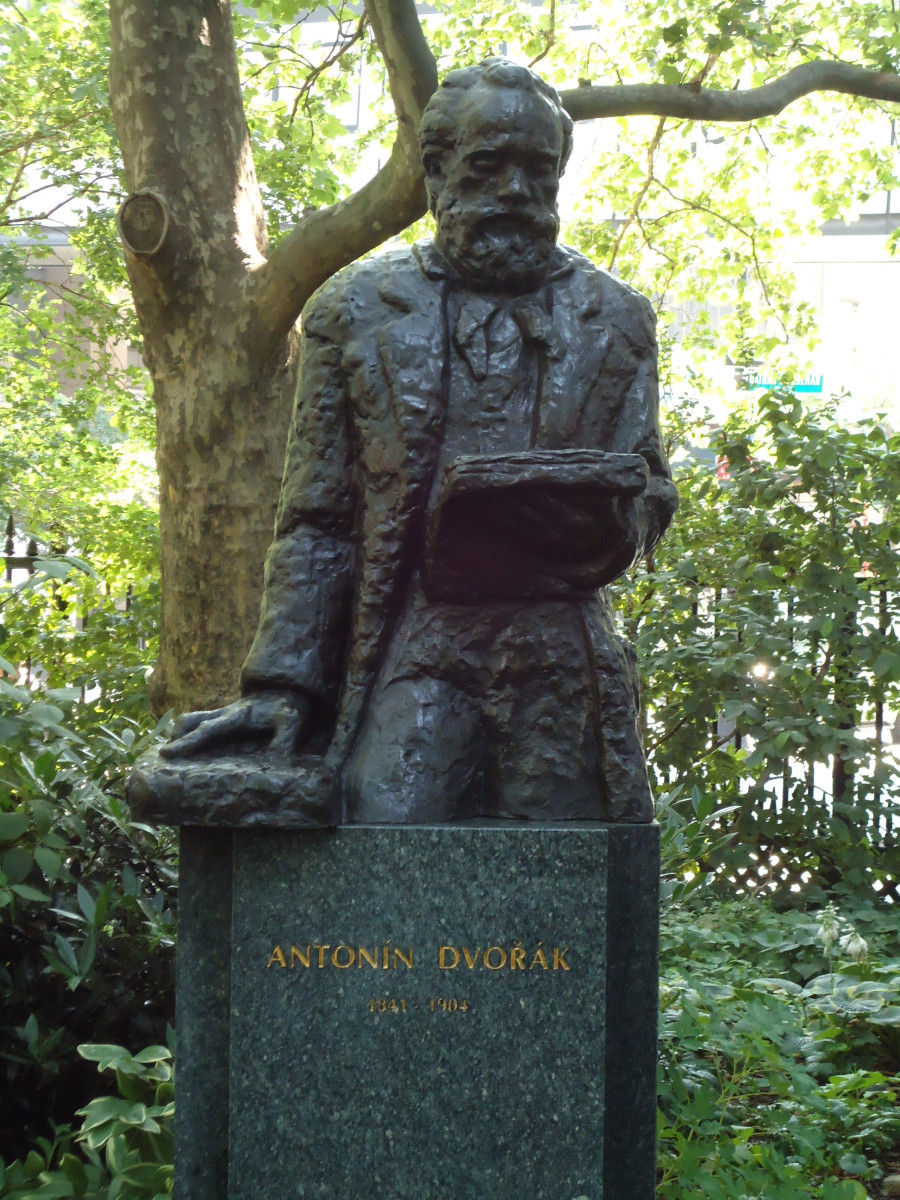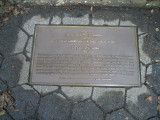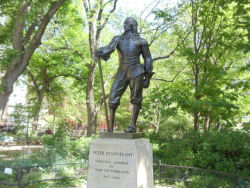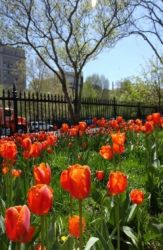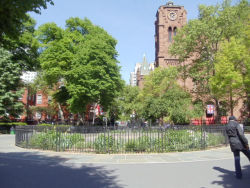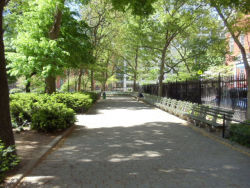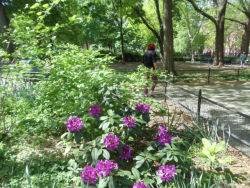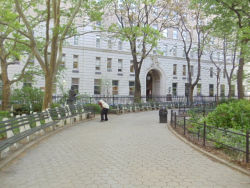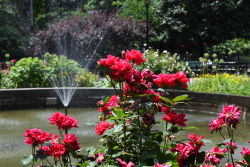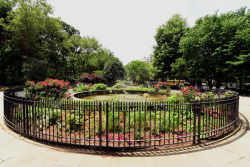Stuyvesant Square
View all monuments in NYC Parks, as well as temporary public art installations on our NYC Public Art Map and Guide.
Antonin Dvorak
| Artist: | Ivan Mestrovic |
| Dedicated: | September 13, 1997 |
| Location: | Northeast corner |
Artwork History
This statue by Croatian-American sculptor Ivan Mestrovic (1883–1962) honors the Czech composer Antonin Dvorak (1841–1904) who made this neighborhood his home for a time, and helped to integrate several musical traditions.
Dvorak was born in the village of Nelahozeves, north of the capital city of Prague, on September 8, 1841. His father kept an inn, and there Dvorak as a child often experienced music-making. He took up the violin, and in 1857 was sent for two years to school in Prague for intensive musical training. At this time Dvorak began composing, and supported himself as a violist, organist, and teacher. He became a violist in the Czech National Theatre Orchestra when it was founded in 1862.
Early on, Dvorak was influenced by the musical compositions of Ludwig van Beethoven (1770–1827) and Franz Schubert (1797–1828), and later by Franz Liszt (1811–1886) and Richard Wagner (1813–1883); he drew equally from Czech and Slavonic folk traditions. In 1873 his cantata Hymnus was publicly performed, and in that year he married Anna Cermakova. An 1875 Austrian state grant brought Dvorak in contact with Johannes Brahms (1833–1897), who provided him with technical advice and found him the influential publisher Fritz Simrock. Over the next 15 years he was a prolific composer, exhibiting a flair for melody, often with a nationalist flavor. His works were performed across Europe, from England to Russia.
In 1892, Dvorak, already internationally renowned, was appointed director of the National Conservatory of Music in America, and settled for three years in New York City at 327 East 17th Street. During his stay in the United States, he was greatly influenced by African-American spirituals and Native American music. His most famous work in this period was the Symphony #9, in E Minor, better known as the New World Symphony (1893). Other notable compositions during his American tenure included the Cello Concerto (1894-95) and the Quartet in F for strings.
Dvorak’s impact as a teacher was broad. His students included Harry T. Burleigh, a prominent black baritone, and Amy Beach, the first well-known American woman composer. His pupils included those who would later teach such musical luminaries as Duke Ellington (1899–1974), Aaron Copland (1900–1990), and George Gershwin (1898–1937). In 1895, Dvorak returned to Bohemia, and in 1901 he became director of the Prague Conservatory. In his last years he composed two string quartets, five symphonic poems, and three operas; he died on May 1, 1904.
In the early 1990s Dvorak’s former house on East 17th Street was designated a city landmark, but rescinded shortly after. Efforts to save the house proved unsuccessful, and it was demolished in 1991. In response, the Dvorak American Heritage Association, in cooperation with the New York Philharmonic and the Stuyvesant Park Neighborhood Association, procured this statue, and raised funds to conserve it, design a new pedestal, install it in the park opposite the site of Dvorak’s home, and endow its maintenance.
In 1963, this bronze portrait bust was given by the Czechoslovak National Council of America to the Philharmonic, but never put on public display. It is believed to be the last work of the noted sculptor Mestrovic, a student of Rodin and the first living artist to receive a one-person exhibition at the Metropolitan Museum of Art. Mestrovic’s plaster model for this work is on display in the lobby of the Manhattan School of Music. Consigned to a rooftop terrace of Avery Fisher Hall at Lincoln Center for the Performing Arts, the sculpture was mounted to an inadequate concrete base for three decades, and suffered extensive environmental corrosion.
As part of the relocation project, the statue was repatined, and a new pedestal of green granite was designed by Czech-American architect Jan Hird Pokorny. On September 13, 1997, the effigy of Dvorak was unveiled here near the site of many of his greatest accomplishments. Several hundred spectators and numerous dignitaries, including Jan Koukal, Mayor of Prague, attended the dedication ceremony. It was followed by a Dvorak concert performed by world-class musicians at nearby St. George’s Church.
Artwork Details
| Description: | Standing three-quarter figure on base, plaque on ground |
| Architect: | Jan Hird Pokorny |
| Materials: | Figure and plaque: bronze; base: Brazilian green granite (verde lavros) |
| Dimensions: | Figure H: 3'11¼" W: 2'10" D: 1'10"; Base H: 3'8½" W: 2'5" D: 1'11¼"; Total H: 7'8¾"; total weight: 2,700 pounds |
| Donor: | The New York Philharmonic and the Dvorak American Heritage Association |
| Cast: | ca. 1960 |
Inscription
Pedestal:ANTONIN DVORAK / 1841 - 1904
Plaque in ground:
GIFT OF THE / NEW YORK PHILHARMONIC / AND THE / DVORAK AMERICAN HERITAGE ASSOCIATION / TO THE / CITY OF NEW YORK / 1997 / THIS BRONZE STATUE BY IVAN MESTROVIC (1883-1962) WAS COMMISSIONED BY THE CZECHOSLOVAK / NATIONAL COUNCIL OF AMERICA AND PRESENTED TO THE NEW YORK PHILHARMONIC IN 1963. IT WAS / PLACED HERE BY THE DVORAK AMERICAN HERITAGE ASSOCIATION AND THE STUYVESANT PARK / NEIGHBORHOOD ASSOCIATION TO HONOR THE GREAT CZECH COMPOSER ANTONIN DVORAK, WHO LIVED / FROM 1892 TO 1895 IN A HOUSE THAT STOOD AT 327 EAST 17TH STREET. THERE HE COMPOSED THE / SYMPHONY NO. 9 ("FROM THE NEW WORLD") AND OTHER MASTERPIECES, MANY OF WHICH WERE / INSPIRED BY, IN HIS WORDS, THE "NEGRO MELODIES" AND "AMERICAN INDIAN MUSIC" THAT HE ADMIRED. / FUNDS TO ERECT THIS MONUMENT WERE RAISED BY PUBLIC SUBSCRIPTION. /
Please note, the NAME field includes a primary designation as well as alternate namingsoften in common or popular usage. The DEDICATED field refers to the most recent dedication, most often, butnot necessarily the original dedication date. If the monument did not have a formal dedication, the yearlisted reflects the date of installation.
For more information, please contact Art & Antiquities at (212) 360-8163.
Check out your park's Vital Signs
Clean & Safe
Green & Resilient
Empowered & Engaged Users
Share your feedback or learn more about how this park is part of a
Vital Park System
